A frame structure is an assembly of members and joints (usually called Nodes) which is designed to support a load. Examples of frame structures include roof trusses, bridges, pylon towers etc.
The members in this framed structure can be as ties or struts, depending on the type of force they support.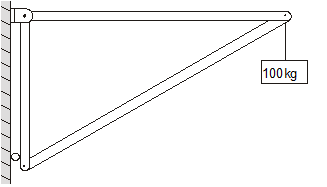
Members that are in compression, due to external forces trying to compress them, are known as Struts.
Members that are in tension, due to external forces trying to pull them apart, are known as Ties.
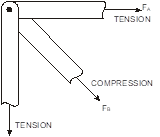 Nodes
NodesThe members are either in compression (strut) or tension (tie). They can be represented at the node as shown below -
FB is under compression and pushes into the node, FA is under tension and pulls away from the node.
SUM OF THE MOMENTS = 0 S Mo = 0
SUM OF THE VERTICAL FORCES = 0 S FV = 0
SUM OF THE HORIZONTAL FORCES = 0 S FH = 0
When solving frame structures some analysis of the structure is required to determine the best starting point and which of the conditions of static equilibrium to apply first.
For this frame structure it is not necessary to use moments to help find the forces in the members. .
The node with the 900N load acting has only one unknown vertical component.
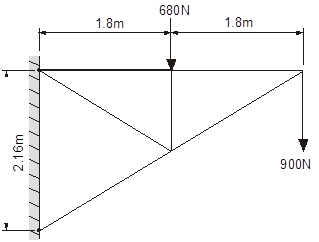
As all vertical forces acting on the node must equal zero then FV must equal 900N.
By using trigonometry it is now possible to find the other forces acting on this node.
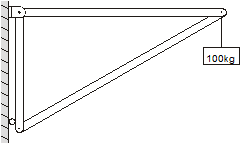 Worked Example
Worked Example
For the crane shown below we shall find the forces in the members and the reaction forces at the wall.
The framework is supported at two points. The hinge support at the top is being pulled away from the wall. R1 will act against this pull and keep the hinge attached to the wall. The roller support is being pushed into the wall. R2 will act against this force and in the opposite direction as shown below.
As member B is acting on a roller then R2 will be at 90° to member C
As R1 is acting at a hinge support there will be a vertical and horizontal component. At this stage guess the direction of R1.
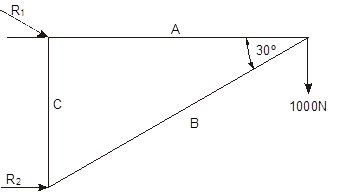
If a wrong assumption about the member being in tension or compression or the direction of a force is made then a negative value will be produced from the calculation. If this is the case the direction of the force is simply reversed
To find the forces in the members and the reactions at the supports, study each of the structure nodes separately.
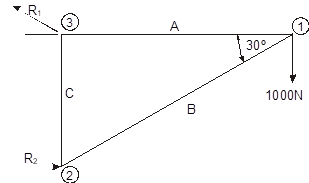
Node 1
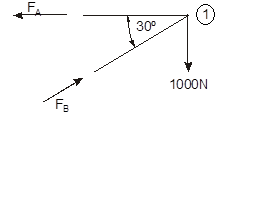 The forces acting on node 1 are shown below.
The forces acting on node 1 are shown below.
Note - an assumption has been made about the direction of FA and FB.
FA is assumed to be in tension and acting away from the node 1.
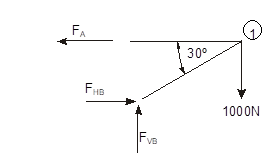 FB is assumed to be in compression and acting in towards the node 1.
FB is assumed to be in compression and acting in towards the node 1.
Split FB into its horizontal (FHB) and vertical (FVB) components.
Apply a condition of static equilibrium -
SFV = 0
As the sum of Vertical forces is equal to zero then the vertical component of FB (FVB) is 1000N acting up.
From this we can find FB - we can redraw FB and the two components FHB and FVB to form a triangle as shown below.
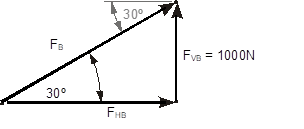
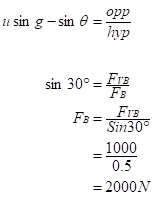
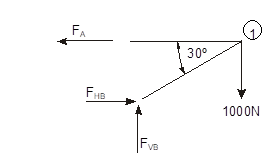 The force in member A (FA) will equal and opposite to FHB.
The force in member A (FA) will equal and opposite to FHB.
Find FHB -
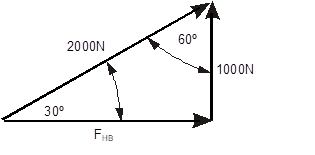
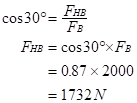
From above FA = 1732N
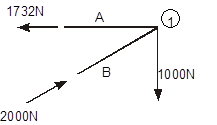
This diagram shows all the forces acting at node 1.
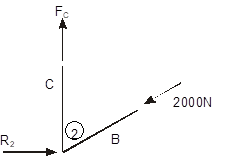 There are three forces acting at node 2.
There are three forces acting at node 2.
During analysis of node 1, FB was found to be 2000N and was not negative so the assumed direction towards the node (compression) was correct.
In node 1, FB is shown to be acting as a compressive force towards the node with a magnitude of 2000N.
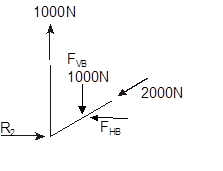
FC will be equal and opposite to the Vertical component of FB (FVB).
From analysis of node 1 FVB was equal to 1000 N therefore -
FC = 1000 N
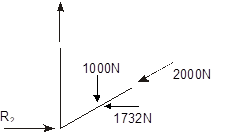 As R2 is a roller support the reaction will be at 90° to the surface.
As R2 is a roller support the reaction will be at 90° to the surface.
R2 will be equal to the Horizontal component of FB.
From above HB was equal to 1732 N therefore -
R2 = 1732N
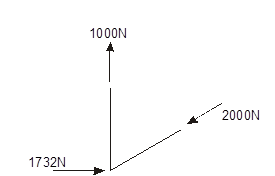
The forces acting at node 2 are shown below.
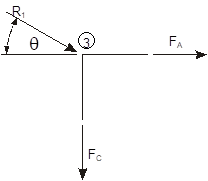 Node 3 has three forces acting on it.
Node 3 has three forces acting on it.
R1 will be equal and opposite to the resultant of FA and FC.
From analysis of node 1 FA was found to be 1732N.
From analysis of node 2 FC was found to be 1000N
Find resultant of FA & FC - FR
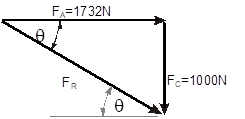

Find angle of resultant (q) -
|
The task was to find the forces in the members and the reactions forces at the supports. The results can be shown as below -
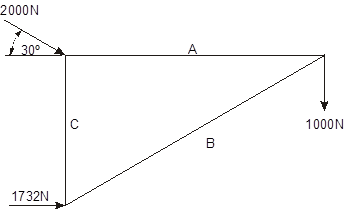
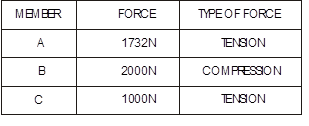
Source: http://www.earlstonhigh.scotborders.sch.uk/learningzone/technical/Revision%20Notes/HTS%20Revision%20notes/3-2%20Revision.doc
Web site to visit: http://www.earlstonhigh.scotborders.sch.uk
Author of the text: indicated on the source document of the above text
If you are the author of the text above and you not agree to share your knowledge for teaching, research, scholarship (for fair use as indicated in the United States copyrigh low) please send us an e-mail and we will remove your text quickly. Fair use is a limitation and exception to the exclusive right granted by copyright law to the author of a creative work. In United States copyright law, fair use is a doctrine that permits limited use of copyrighted material without acquiring permission from the rights holders. Examples of fair use include commentary, search engines, criticism, news reporting, research, teaching, library archiving and scholarship. It provides for the legal, unlicensed citation or incorporation of copyrighted material in another author's work under a four-factor balancing test. (source: http://en.wikipedia.org/wiki/Fair_use)
The information of medicine and health contained in the site are of a general nature and purpose which is purely informative and for this reason may not replace in any case, the council of a doctor or a qualified entity legally to the profession.
The texts are the property of their respective authors and we thank them for giving us the opportunity to share for free to students, teachers and users of the Web their texts will used only for illustrative educational and scientific purposes only.
All the information in our site are given for nonprofit educational purposes